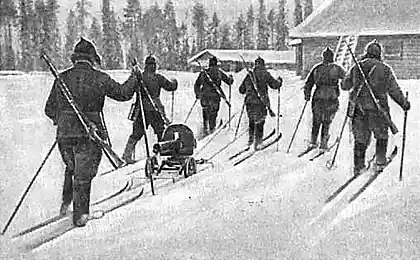1682
Those who came before us?
Nails that millions of years
I wanted to read that niubd on the eternal theme. As you post the question in the subject? It would have all been proved, and all is clear? Not the fact probably ...
Creation of human hands, walled in rocks dating back millions of years, until recently ignored. And not just anybody, and scientists themselves. After all, the findings violate universally recognized fact of human evolution, and even the formation of life on Earth. We have already reported on some of the findings. What artifacts caught in rocks, in which the existing theory of the origin and development of man, there should be absolutely nothing?
Let's not talk about the many discovered stone tools, which were produced at a time when, according to the assertions of scientists, man did not exist. Think of the more exotic finds. For example, in 1845 in one of the quarries in Scotland it was discovered nail vkraplёnny in a block of limestone, and in 1891 in an American newspaper article appeared about a gold chain about 25 cm long, which proved to be immured in a lump of coal, not age less than 260 million. years.
Reporting highly unusual discovery was published in a scientific journal in 1852. It was about a mysterious vessel height of about 12 cm, the two halves of which were discovered after the explosion at one of the quarries. This vase with clear images of flowers, was inside the rock age of 600 million. Years. In 1889, in Idaho (USA) during the drilling of the well, at a depth of 90 m was extracted figure female height of about 4 cm. According to geologists, her age is not less than 2 million. Years.
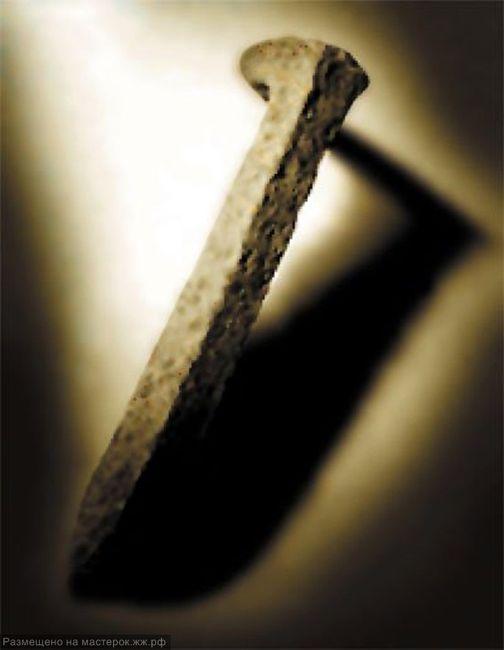
Vase found in the rock age of 600 million.
Years
From abnormal findings in the XIX century, move on to the reports about the artifacts in closer to our times. In 1912, on one of the power plants in the state of Oklahoma, in crushing the massive lumps of coal, it had the most ordinary steel mug ... The fact that she was in fact lies in the coal showed the characteristic notch in the remaining pieces of rock. I found out that the age of coal delivered to the power plant was about 300 million. Years. A unique find, again in Oklahoma, was made in one of the coal mines in 1928, after blasting in the mine shaft was found a real wall, built of perfectly smooth cubic concrete blocks. It is curious that the management of the mine immediately stop the development of coal miners and forbade anyone to report what they saw.
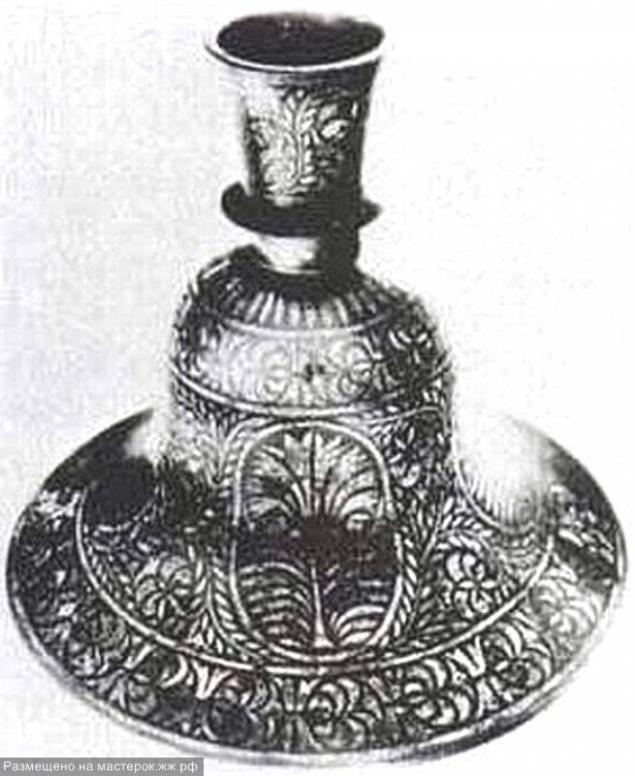
Iron circle found in the coal age of 300 million.
Years
Many were surprised in 1968 by quarry workers Saint-Jean-de-Livet (France), when the inside of the Cretaceous formation age of about 65 million. Years they found semi-oval metal tubes of different sizes, obviously made by intelligent beings. More recently, already in Russia, in the ancient rock it was found the most common bolt that hit the stone of about 300 million. Years ago ...
The last sensation among abnormal findings can be considered Chandarskuyu map discovered in Bashkortostan. Map is a stone slab with the relief image of the area from the hill to the city of Ufa Meleuz. The map shows the numerous channels, as well as dams and water intakes. Curiously, the plate with a map is like three layers: the first is the foundation and is a substance resembling cement, two other layers of silicon and porcelain clearly intended not only to better display the details of relief, but also for the safety of the entire image as a whole. On the map there is no picture Chandarskoy roads, but there is a geometrically correct unusual flat ground, resembling small airfields. Striking age of this unique find: according to scientists, it about 50 million. Years. According to the pro-rector of the Bashkir University AN Chuvyrov, the card can make the aliens from outer space, which in ancient times were going to settle our planet.
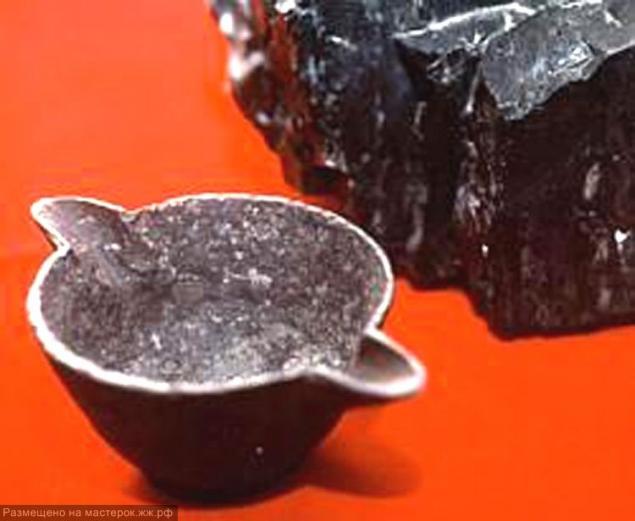
Bolt found in the rock age of 300 million.
Years
So, we moved on to the question of the authorship of numerous anomalous finds. Perhaps the easiest way, and the better for all scientists blame accidents on humanoids. Here they are the bolt lost, the mug, but in Bashkortostan and map one-ton dropped it ... What we have now either find in the bowels of the earth, everything is the work of aliens ... But that's the extent of these "tricks", and its geography is impressive: I start to think that once upon a time, our Earth was inhabited by aliens just ... Then, perhaps, we are aliens too? ..
Much more serious hypothesis to explain the abnormal findings in the rocks, is the assumption of the existence of the world in the distant past proto-civilization, which reached a high development and disappeared in a global catastrophe. This hypothesis is most annoying scientists, because it breaks down more or less coherent concept not only the origin and development of mankind, and education in general, life on Earth.
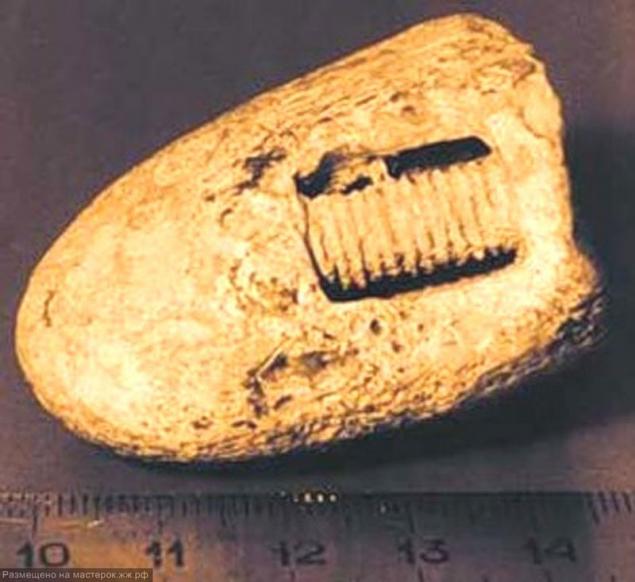
"Spark Plug", found in the rock age of 500 thousand. Years
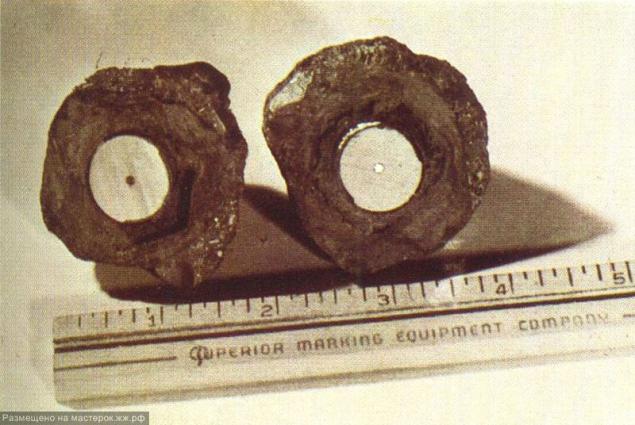
"Spark Plug" under x-ray
Well, let's say, people existed millions of years ago, and even ran races with the dinosaurs, and then have them stay any fossilized bones? The fact of the matter is that the left! In 1850, in Italy, in the rocks of the age of 4 million years. I was found a skeleton in their structure fully corresponds to modern man. In California, in the gold-bearing gravel, age not less than 9 million years. We were also found human remains.
These findings were not isolated, but just like all found in very ancient rocks, human remains, cuts the ground from under the feet of conservative scientists: abnormal bone or hidden in storerooms or declared a fake. In the end, it turns out that at the disposal of scientists are not only anomalous artifacts, but also very ancient remains of people that do not fit into any chronological framework of alleged human evolution.
What to do with all this?
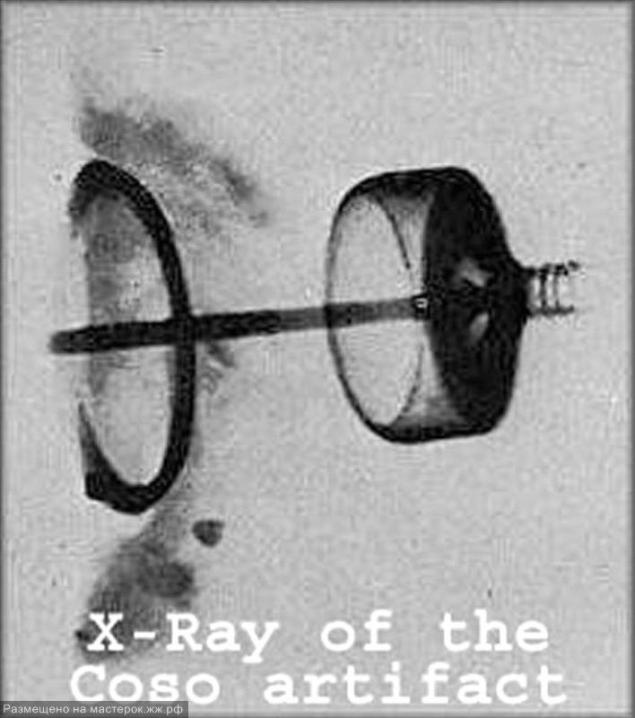
Engraved scope
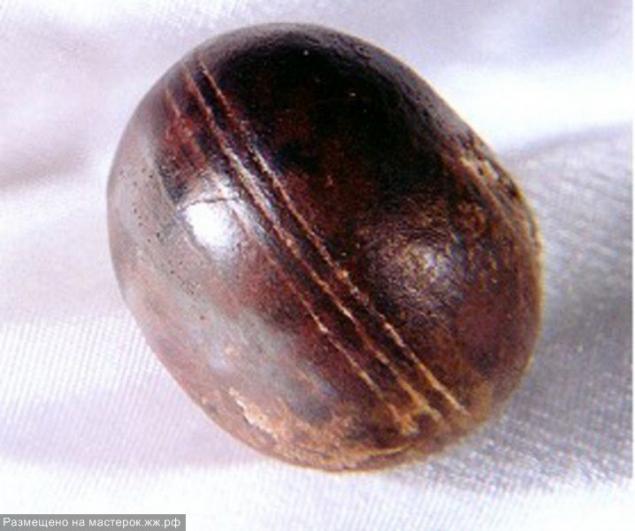
Battery Baghdad
Of course, some way to systematize and coordinate among themselves. But this requires a truly courageous people. The real revolutionaries are those who dare to revise the history of the development of intelligent life on Earth. It is possible that they, in addition to the scientific environment, and will press government officials, and even the secret services. We also do not like the extreme panic, and evidence of the disaster, which killed a similar to us, and can be more powerful civilization, can someone seem superfluous. As for the security services, then think about the mine, which was closed in the state Oklohoma after the discovery of coal among the concrete wall. Who knows, maybe, somewhere is already the coded mine, where under heavy military guard in the bowels of the earth there is a real development of priceless artifacts lost civilization ...
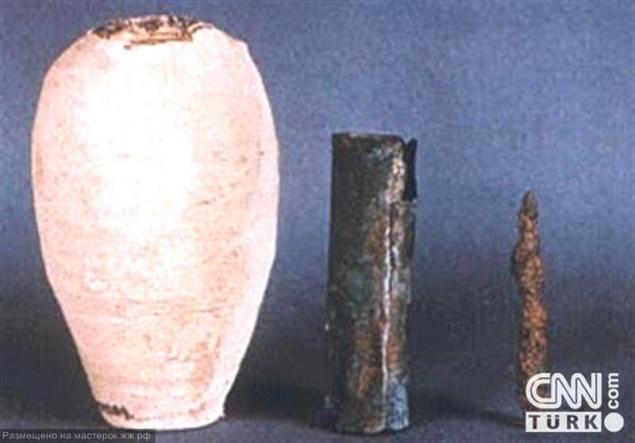
Vase
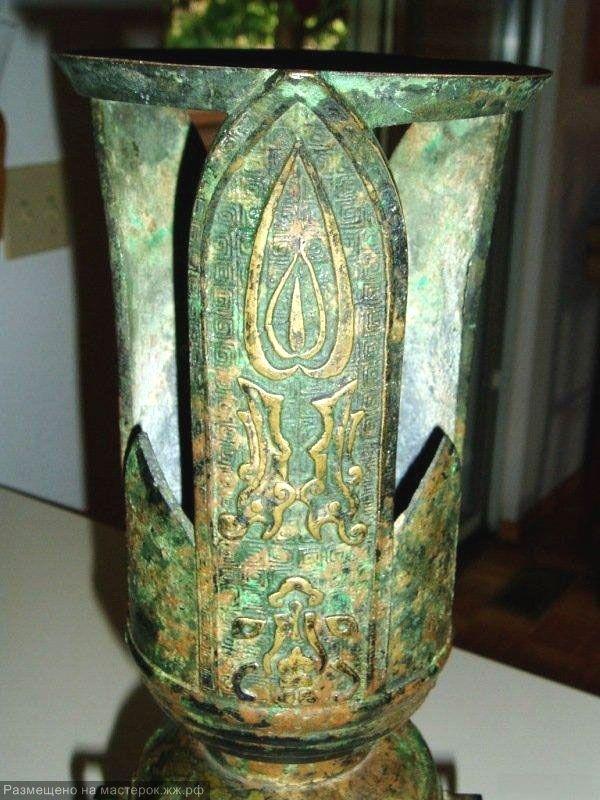
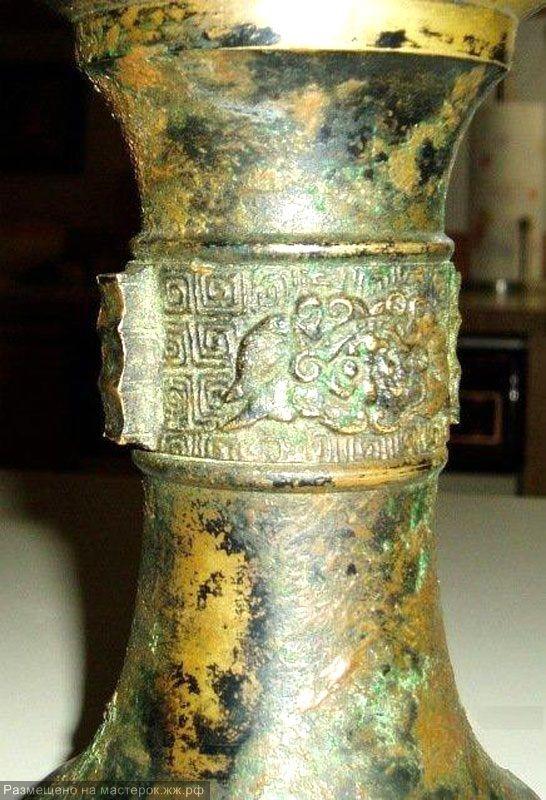
Iron hammer called "Hammer Creator»
Following the recent reports of a sensational discovery in Karelian swamps bolt age of 300 million years. Appropriate to recall that these findings troubled the minds of scientists and earlier. The most interesting of them was made in 1961 in California (USA). Three friends - Meyksell Mike Wallace Lane, and Virginia Meksi - often made trips to the area of Coso Mountain, beautiful to look for precious stones, which they then sold in their gift shop. Of special interest friends called geodes - mineral formations spherical shape, in the internal voids which are rare beautiful growths of crystals of rock crystal or amethyst. Similar geode stone and looking for lovers in the suburban Rusavkine where sometimes come across good brushes amethyst crystals.
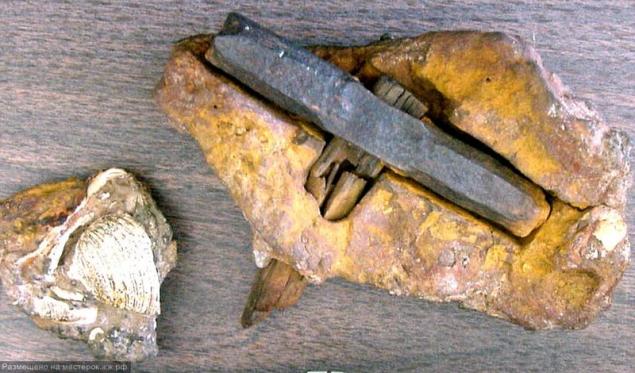
Antikiteriysky computer
Let's recall the details about this discovery ...
At the beginning of 1900 Elias Stadiatos with a group of Greek divers fished marine sponges off the coast of a small rocky island Andikitira, located between the southern tip of the Peloponnese and Crete. Rising after a dive Stadiatos began to mutter something about "a lot of dead naked women", lying on the seabed. Upon further inspection of the bottom at a depth of nearly 140 feet of a diver found the skeleton of a sunken Roman cargo ship 164 feet long. On the ship were I in the subjects. Don. e .: marble and bronze statues (dead naked women), coins, gold jewelry, pottery, and, as it turned out, the oxide bronze pieces that fell apart immediately after lifting from the seabed. Findings from the wreck were immediately investigated, described and forwarded to the National Museum of Athens for display and storage. May 17, 1902 Greek archeologist Spyridon Stais studying unusual growths covered with marine debris from sunken ships that had lain in the sea up to 2000 years old, noticed in one piece of gear with an inscription, similar to the Greek letter.
Next to the unusual items was discovered a wooden box, but it is, as well as the wooden boards from the ship, soon dried up and crumbled. Further research and thorough cleaning of the oxide bronze revealed several fragments of the mysterious object. Soon was found elaborate bronze pinion mechanism, the size of 33x17x9 cm. Stais believed that the mechanism is an ancient astronomical clock, however, according to the conventional assumptions of the time, the subject was too complex mechanism for the beginning I in. Don. e. - So dated the wreck of it found on pottery. Many researchers believe that the mechanism is a medieval astrolabe - an astronomical instrument for observing the movement of the planets, used in navigation (the oldest known specimens was Iraqi astrolabe IX c.). However, a consensus regarding the dating and the goals of the artifact could not then come, and soon forgot about the mysterious object.
In 1951, British physicist Derek de Solla Price, then a professor of the history of science at Yale University, became interested ingenious mechanism with a sunken ship and began his detailed study. In June 1959, after eight years of careful study of X-ray images of the subject, the results of the analysis were presented in an article titled "Ancient Greek Computer" and published in "Scientific American." With the help of X-rays failed to consider at least 20 separate gears, including semiaxial previously considered the invention of the XVI century. Semiaxial gear allows two rods to rotate at different speeds, like the rear axle vehicles. Summing up the results of his research, Price concluded that the Antikythera find a wreckage "greatest astronomical clock" prototype "modern analog computer." His article in the academic world met with disapproval. Some professors refused to believe in the possibility of the existence of such an instrument, and suggested that the object must have hit the sea in the Middle Ages, and happened to be among the wreckage of the crashed ship.
In 1974, Price published the results of a comprehensive study in the monograph entitled "Greek instruments: Antikythera Mechanism - a calendar computer 80 BC. e. ". In his work he analyzed made by the Greek Christos Karakalosom radiography X-rays and his findings gamma radiography. Further research Pryce revealed that ancient scientific instrument is actually made up of more than 30 gears, but most of them are not fully represented. However, even surviving fragments allow Pryce to conclude that during the rotation of the handle mechanism had to show the motion of the moon, the sun, perhaps the planets and climbing the main stars. According to the functions performed by the device resembles a complex astronomical computer. It was a working model of the solar system, once located in a wooden box with a hinged door that protects the inner part of the mechanism. Inscriptions and location of gear (as well as one-year terms of the object) Price led to the conclusion that the mechanism associated with the name of the Rhodes Geminusa - Greek astronomer and mathematician who lived around 110-40 years. Don. e. Price decided that the Antikythera Mechanism was designed on the Greek island of Rhodes, that the coast of Turkey, perhaps even by Geminusom about 87 BC. e. Among the remains of the cargo, which sailed wrecked ship were indeed found jars of Rhodes. Apparently, they were transported from Rhodes to Rome. The date when the ship went under the water, with a certain degree of confidence can be attributed to the 80th BC. e. Subject at the time of the crash was for several years, so today the date of creating Antikythera Mechanism is considered to be in '87 BC. e.
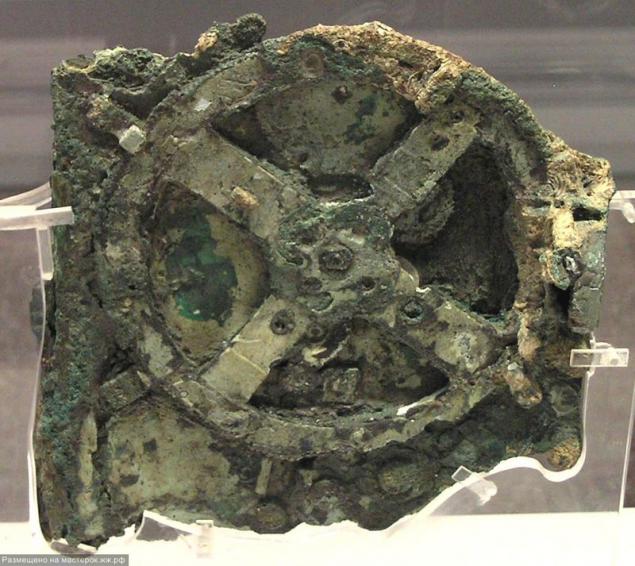
In this case, it is possible that the device was created Geminusom Rhodes. This conclusion seems plausible also because Rhodes in those days was known as a center for astronomic and technological research. In II. Don. e. Greek writer and engineer Philo of Byzantium described polybolos that seen on Rhodes. These stunning catapults could shoot without reloading: they are two gear connected chain, which is driven via the gate (a mechanical device consisting of a horizontal cylinder with a handle by which it can rotate). It Rhodes Greek Stoic philosopher, astronomer and geographer Posidonius (135-51 gg. BC. E.) Was able to disclose the nature of the tides. Moreover, Posidonius quite accurate (for the time) to calculate the size of the sun and the moon and the magnitude of its distance. Name astronomer Hipparchus of Rhodes (190-125 gg. BC. E.) Associated with the opening of trigonometry and the creation of the first star catalog. Moreover, he was one of the first Europeans, who, using data from the Babylonian astronomy and his own observations, to explore the solar system. Perhaps part of the received data Hipparchus and his ideas were used when creating the Antikythera Mechanism.
Antikythera device is the oldest extant example of complex mechanical technology. The use of gear wheels more than 2000 years ago, causing great surprise, and the skill with which they were carried out, compared with the art of watchmaking in the XVIII century. In recent years, it has created several working copies of ancient computer. One of them produced an Austrian computer scientist Allan George Bromley (1947-2002) from the University of Sydney and clockmaker Frank Percival. Bromley also made most clear X-ray images of the subject, which served as the basis for creating a three-dimensional model of the mechanism of his student Bernard Garner. A few years later, the British inventor, author orreri (desktop demonstration of mechanical planetarium - a model of the solar system), John Gliv constructed a more detailed pattern: in the front of the working model positioned dial displays the movement of the Sun and Moon on the zodiacal constellations of the Egyptian calendar.
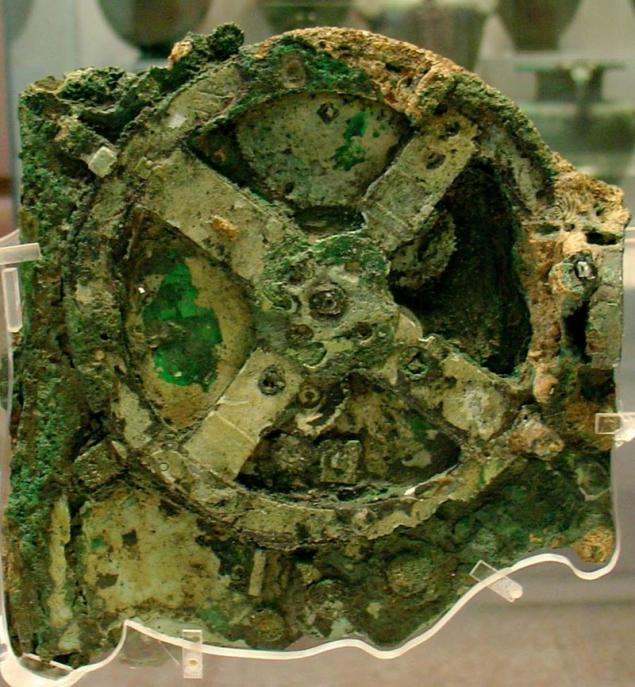
Another attempt to explore and reconstruct the artifact in 2002 undertook a curator of the Museum of Science Mechanical Engineering Michael Wright, together with Allan Bromley. While some findings Wright have differences difficult to Derek de Solla Price, he came to the conclusion that the mechanism - even more amazing invention than assumed Price. In justifying his theory, Wright relied on X-ray images of the subject and used the method of so-called linear tomography. This technology allows you to see the subject in detail, considering only one of its plane, or edge, clearly focusing image. Thus Wright managed to scrutinize the gears and to establish that the device could accurately simulate not only the movement of the sun and the moon, but also all the planets known to the ancient Greeks: Mercury, Venus, Mars, Jupiter and Saturn. Apparently, thanks arranged in a circle on the front of the bronze artifact label, which stands for the zodiacal constellations, the mechanism could (and quite accurate) to calculate the position of the known planets in relation to any date. In September 2002, Wright finished model, and it has become part of the exhibition "Ancient Technology" Technopark Museum of Athens.
Many years of research, attempts to reconstruct and a variety of assumptions and did not give a precise answer to the question: How was working Antikythera Mechanism. There were theories about what he was doing astrological function and used for the computerization of horoscopes, created as a training model of the solar system or even as a sophisticated toy for the rich. Derek de Solla Price considered evidence of the mechanism established traditions of high-tech metal processing ancient Greeks.
e.
I wanted to read that niubd on the eternal theme. As you post the question in the subject? It would have all been proved, and all is clear? Not the fact probably ...
Creation of human hands, walled in rocks dating back millions of years, until recently ignored. And not just anybody, and scientists themselves. After all, the findings violate universally recognized fact of human evolution, and even the formation of life on Earth. We have already reported on some of the findings. What artifacts caught in rocks, in which the existing theory of the origin and development of man, there should be absolutely nothing?
Let's not talk about the many discovered stone tools, which were produced at a time when, according to the assertions of scientists, man did not exist. Think of the more exotic finds. For example, in 1845 in one of the quarries in Scotland it was discovered nail vkraplёnny in a block of limestone, and in 1891 in an American newspaper article appeared about a gold chain about 25 cm long, which proved to be immured in a lump of coal, not age less than 260 million. years.
Reporting highly unusual discovery was published in a scientific journal in 1852. It was about a mysterious vessel height of about 12 cm, the two halves of which were discovered after the explosion at one of the quarries. This vase with clear images of flowers, was inside the rock age of 600 million. Years. In 1889, in Idaho (USA) during the drilling of the well, at a depth of 90 m was extracted figure female height of about 4 cm. According to geologists, her age is not less than 2 million. Years.

Vase found in the rock age of 600 million.
Years
From abnormal findings in the XIX century, move on to the reports about the artifacts in closer to our times. In 1912, on one of the power plants in the state of Oklahoma, in crushing the massive lumps of coal, it had the most ordinary steel mug ... The fact that she was in fact lies in the coal showed the characteristic notch in the remaining pieces of rock. I found out that the age of coal delivered to the power plant was about 300 million. Years. A unique find, again in Oklahoma, was made in one of the coal mines in 1928, after blasting in the mine shaft was found a real wall, built of perfectly smooth cubic concrete blocks. It is curious that the management of the mine immediately stop the development of coal miners and forbade anyone to report what they saw.

Iron circle found in the coal age of 300 million.
Years
Many were surprised in 1968 by quarry workers Saint-Jean-de-Livet (France), when the inside of the Cretaceous formation age of about 65 million. Years they found semi-oval metal tubes of different sizes, obviously made by intelligent beings. More recently, already in Russia, in the ancient rock it was found the most common bolt that hit the stone of about 300 million. Years ago ...
The last sensation among abnormal findings can be considered Chandarskuyu map discovered in Bashkortostan. Map is a stone slab with the relief image of the area from the hill to the city of Ufa Meleuz. The map shows the numerous channels, as well as dams and water intakes. Curiously, the plate with a map is like three layers: the first is the foundation and is a substance resembling cement, two other layers of silicon and porcelain clearly intended not only to better display the details of relief, but also for the safety of the entire image as a whole. On the map there is no picture Chandarskoy roads, but there is a geometrically correct unusual flat ground, resembling small airfields. Striking age of this unique find: according to scientists, it about 50 million. Years. According to the pro-rector of the Bashkir University AN Chuvyrov, the card can make the aliens from outer space, which in ancient times were going to settle our planet.

Bolt found in the rock age of 300 million.
Years
So, we moved on to the question of the authorship of numerous anomalous finds. Perhaps the easiest way, and the better for all scientists blame accidents on humanoids. Here they are the bolt lost, the mug, but in Bashkortostan and map one-ton dropped it ... What we have now either find in the bowels of the earth, everything is the work of aliens ... But that's the extent of these "tricks", and its geography is impressive: I start to think that once upon a time, our Earth was inhabited by aliens just ... Then, perhaps, we are aliens too? ..
Much more serious hypothesis to explain the abnormal findings in the rocks, is the assumption of the existence of the world in the distant past proto-civilization, which reached a high development and disappeared in a global catastrophe. This hypothesis is most annoying scientists, because it breaks down more or less coherent concept not only the origin and development of mankind, and education in general, life on Earth.

"Spark Plug", found in the rock age of 500 thousand. Years

"Spark Plug" under x-ray
Well, let's say, people existed millions of years ago, and even ran races with the dinosaurs, and then have them stay any fossilized bones? The fact of the matter is that the left! In 1850, in Italy, in the rocks of the age of 4 million years. I was found a skeleton in their structure fully corresponds to modern man. In California, in the gold-bearing gravel, age not less than 9 million years. We were also found human remains.
These findings were not isolated, but just like all found in very ancient rocks, human remains, cuts the ground from under the feet of conservative scientists: abnormal bone or hidden in storerooms or declared a fake. In the end, it turns out that at the disposal of scientists are not only anomalous artifacts, but also very ancient remains of people that do not fit into any chronological framework of alleged human evolution.
What to do with all this?

Engraved scope

Battery Baghdad
Of course, some way to systematize and coordinate among themselves. But this requires a truly courageous people. The real revolutionaries are those who dare to revise the history of the development of intelligent life on Earth. It is possible that they, in addition to the scientific environment, and will press government officials, and even the secret services. We also do not like the extreme panic, and evidence of the disaster, which killed a similar to us, and can be more powerful civilization, can someone seem superfluous. As for the security services, then think about the mine, which was closed in the state Oklohoma after the discovery of coal among the concrete wall. Who knows, maybe, somewhere is already the coded mine, where under heavy military guard in the bowels of the earth there is a real development of priceless artifacts lost civilization ...

Vase


Iron hammer called "Hammer Creator»
Following the recent reports of a sensational discovery in Karelian swamps bolt age of 300 million years. Appropriate to recall that these findings troubled the minds of scientists and earlier. The most interesting of them was made in 1961 in California (USA). Three friends - Meyksell Mike Wallace Lane, and Virginia Meksi - often made trips to the area of Coso Mountain, beautiful to look for precious stones, which they then sold in their gift shop. Of special interest friends called geodes - mineral formations spherical shape, in the internal voids which are rare beautiful growths of crystals of rock crystal or amethyst. Similar geode stone and looking for lovers in the suburban Rusavkine where sometimes come across good brushes amethyst crystals.

Antikiteriysky computer
Let's recall the details about this discovery ...
At the beginning of 1900 Elias Stadiatos with a group of Greek divers fished marine sponges off the coast of a small rocky island Andikitira, located between the southern tip of the Peloponnese and Crete. Rising after a dive Stadiatos began to mutter something about "a lot of dead naked women", lying on the seabed. Upon further inspection of the bottom at a depth of nearly 140 feet of a diver found the skeleton of a sunken Roman cargo ship 164 feet long. On the ship were I in the subjects. Don. e .: marble and bronze statues (dead naked women), coins, gold jewelry, pottery, and, as it turned out, the oxide bronze pieces that fell apart immediately after lifting from the seabed. Findings from the wreck were immediately investigated, described and forwarded to the National Museum of Athens for display and storage. May 17, 1902 Greek archeologist Spyridon Stais studying unusual growths covered with marine debris from sunken ships that had lain in the sea up to 2000 years old, noticed in one piece of gear with an inscription, similar to the Greek letter.
Next to the unusual items was discovered a wooden box, but it is, as well as the wooden boards from the ship, soon dried up and crumbled. Further research and thorough cleaning of the oxide bronze revealed several fragments of the mysterious object. Soon was found elaborate bronze pinion mechanism, the size of 33x17x9 cm. Stais believed that the mechanism is an ancient astronomical clock, however, according to the conventional assumptions of the time, the subject was too complex mechanism for the beginning I in. Don. e. - So dated the wreck of it found on pottery. Many researchers believe that the mechanism is a medieval astrolabe - an astronomical instrument for observing the movement of the planets, used in navigation (the oldest known specimens was Iraqi astrolabe IX c.). However, a consensus regarding the dating and the goals of the artifact could not then come, and soon forgot about the mysterious object.
In 1951, British physicist Derek de Solla Price, then a professor of the history of science at Yale University, became interested ingenious mechanism with a sunken ship and began his detailed study. In June 1959, after eight years of careful study of X-ray images of the subject, the results of the analysis were presented in an article titled "Ancient Greek Computer" and published in "Scientific American." With the help of X-rays failed to consider at least 20 separate gears, including semiaxial previously considered the invention of the XVI century. Semiaxial gear allows two rods to rotate at different speeds, like the rear axle vehicles. Summing up the results of his research, Price concluded that the Antikythera find a wreckage "greatest astronomical clock" prototype "modern analog computer." His article in the academic world met with disapproval. Some professors refused to believe in the possibility of the existence of such an instrument, and suggested that the object must have hit the sea in the Middle Ages, and happened to be among the wreckage of the crashed ship.
In 1974, Price published the results of a comprehensive study in the monograph entitled "Greek instruments: Antikythera Mechanism - a calendar computer 80 BC. e. ". In his work he analyzed made by the Greek Christos Karakalosom radiography X-rays and his findings gamma radiography. Further research Pryce revealed that ancient scientific instrument is actually made up of more than 30 gears, but most of them are not fully represented. However, even surviving fragments allow Pryce to conclude that during the rotation of the handle mechanism had to show the motion of the moon, the sun, perhaps the planets and climbing the main stars. According to the functions performed by the device resembles a complex astronomical computer. It was a working model of the solar system, once located in a wooden box with a hinged door that protects the inner part of the mechanism. Inscriptions and location of gear (as well as one-year terms of the object) Price led to the conclusion that the mechanism associated with the name of the Rhodes Geminusa - Greek astronomer and mathematician who lived around 110-40 years. Don. e. Price decided that the Antikythera Mechanism was designed on the Greek island of Rhodes, that the coast of Turkey, perhaps even by Geminusom about 87 BC. e. Among the remains of the cargo, which sailed wrecked ship were indeed found jars of Rhodes. Apparently, they were transported from Rhodes to Rome. The date when the ship went under the water, with a certain degree of confidence can be attributed to the 80th BC. e. Subject at the time of the crash was for several years, so today the date of creating Antikythera Mechanism is considered to be in '87 BC. e.

In this case, it is possible that the device was created Geminusom Rhodes. This conclusion seems plausible also because Rhodes in those days was known as a center for astronomic and technological research. In II. Don. e. Greek writer and engineer Philo of Byzantium described polybolos that seen on Rhodes. These stunning catapults could shoot without reloading: they are two gear connected chain, which is driven via the gate (a mechanical device consisting of a horizontal cylinder with a handle by which it can rotate). It Rhodes Greek Stoic philosopher, astronomer and geographer Posidonius (135-51 gg. BC. E.) Was able to disclose the nature of the tides. Moreover, Posidonius quite accurate (for the time) to calculate the size of the sun and the moon and the magnitude of its distance. Name astronomer Hipparchus of Rhodes (190-125 gg. BC. E.) Associated with the opening of trigonometry and the creation of the first star catalog. Moreover, he was one of the first Europeans, who, using data from the Babylonian astronomy and his own observations, to explore the solar system. Perhaps part of the received data Hipparchus and his ideas were used when creating the Antikythera Mechanism.
Antikythera device is the oldest extant example of complex mechanical technology. The use of gear wheels more than 2000 years ago, causing great surprise, and the skill with which they were carried out, compared with the art of watchmaking in the XVIII century. In recent years, it has created several working copies of ancient computer. One of them produced an Austrian computer scientist Allan George Bromley (1947-2002) from the University of Sydney and clockmaker Frank Percival. Bromley also made most clear X-ray images of the subject, which served as the basis for creating a three-dimensional model of the mechanism of his student Bernard Garner. A few years later, the British inventor, author orreri (desktop demonstration of mechanical planetarium - a model of the solar system), John Gliv constructed a more detailed pattern: in the front of the working model positioned dial displays the movement of the Sun and Moon on the zodiacal constellations of the Egyptian calendar.

Another attempt to explore and reconstruct the artifact in 2002 undertook a curator of the Museum of Science Mechanical Engineering Michael Wright, together with Allan Bromley. While some findings Wright have differences difficult to Derek de Solla Price, he came to the conclusion that the mechanism - even more amazing invention than assumed Price. In justifying his theory, Wright relied on X-ray images of the subject and used the method of so-called linear tomography. This technology allows you to see the subject in detail, considering only one of its plane, or edge, clearly focusing image. Thus Wright managed to scrutinize the gears and to establish that the device could accurately simulate not only the movement of the sun and the moon, but also all the planets known to the ancient Greeks: Mercury, Venus, Mars, Jupiter and Saturn. Apparently, thanks arranged in a circle on the front of the bronze artifact label, which stands for the zodiacal constellations, the mechanism could (and quite accurate) to calculate the position of the known planets in relation to any date. In September 2002, Wright finished model, and it has become part of the exhibition "Ancient Technology" Technopark Museum of Athens.
Many years of research, attempts to reconstruct and a variety of assumptions and did not give a precise answer to the question: How was working Antikythera Mechanism. There were theories about what he was doing astrological function and used for the computerization of horoscopes, created as a training model of the solar system or even as a sophisticated toy for the rich. Derek de Solla Price considered evidence of the mechanism established traditions of high-tech metal processing ancient Greeks.
e.






